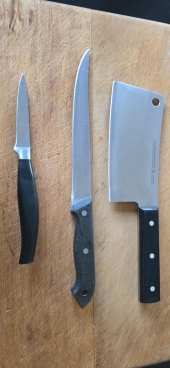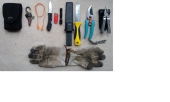posted 1 year ago
SIDE NOTES:
I’ve owned quite a few knives over the years, including pocket knives. All but a few were average in quality, regardless of name fame and claims to the contrary.
Generally, my knives were made with more attention to rust resistance (stainlessness) and inexpensive production than holding an edge. In short, and regardless of cost, most my knives were cheap and required frequent sharpening. For me, that is the stuff of frustration.
To the end I could avoid frequent sharpening, I researched knives and the steel used to make them. I learned there were many different steels, and some held edges better than those I used in the past.
The world of knife metals is an amazing, if daunting one. A few steels show up often, when seeking high quality, enduring steel blades. Their use in the manufacture of blades results in significantly more expensive knives, but knives that use them pale those with which many of us are familiar, when it comes to edge retention and such.
Now, decades into this thing I call my life, I’ve developed a GREAT appreciation for the “cry once” approach to buying, be it home appliances, kitchen or shop tools and equipment, quality footwear, and so on.
Mindful of the foregoing, and subsequent to my limited metals research, I made a plunge and bought a Spyderco pocket knife with SV 30 steel (also known as CPM S30V steel). Several years of use in, I remain pleased with the performance of that knife for its edge retention. For example, cut a bunch of cardboard with a cheap knife, then do the same with a S30V steel blade and you will note a significant difference in how the blades perform.
From there, and based on information gleaned from more research, I, eventually, bought a Spyderco Paramilitary in the CPM S110V steel version. The S110 FAR pales even the S30V for edge retention. For example, I can cut a lot of cardboard, then still push cut a piece of copy paper. In fact, I went nearly a month before feeling compelled to sharpen the blade, though I'd used it as much as my other knives.
To be fair and before continuing, it is fact you tend to suffer more at the loss of one of these knives because of their cost. Still, they will spoil you, after using that old pocket knife your dad had when he was a kid, and you will be inclined to risk packing them.
Another point to remember is, you will see articles talk about how hard some steels can be to sharpen. That stands to reason, depending on circumstance (sharpening stones, methods and steel). However, I have not found that to be an issue with my high end steel knives because I both use a quality sharpening system AND use diamond sharpening stones. In the end, touching it up with my sharpener goes quickly.
[VALUE OF EVERYDAY CARRYING A POCKET KNIFE]
Though it’s easy to take having a knife for granted, it remains many problems disappear because you do. Having one with you is a bit like owning a circular saw, electric drill or other tool. Doors open and, though you might have been able to do something without it using other methods, having one makes many tasks far easier to get done. Mail gets opened. Cardboard gets cut to fit the trash can. Strings get trimmed. Wires get stripped. . . .
Having a pocket knife is a bit like having the flashlight I started carrying too. Many problems disappear because I have it (mine is small, pocket friendly one needing only one AAA battery). Keyholes are easy to find. I can locate that OBII connector on the car or truck. And so on. Just last night I had to rescue a friend, when his car broke down. When the tow truck arrived, the driver was having trouble with the tie downs. Having the flashlight in my pocket cut down on our frustration.
[SHARPENING]
A critical thing to consider regarding carrying pocket knives is, a good knife sharpening system. You will have to maintain your blade. Having a good sharpening system will not only allow you to do that for your pocket knife, it will allow you to bring your kitchen, hunting and other knives up to optimum efficiency too.
I took the plunge and spent money on an Edge Pro. That was a scary $200.00 expenditure. The purchase came with the expected buyers remorse, but that went away fairly quickly with use of the sharpener and improved performance from all my knives.
Before I INVESTED in an expensive sharpener, I was a member of that class of people who would grab a knife and use it to rock my way through a fresh potato. After buying and using the Edge Pro, I was talking with my wife and she commented to the effect the potatoes seemed different. Maybe not fresh, so somewhat soft, because they were easy to cut up. I’d noted the same thing. It turned out neither of us had really used sharp knives very often.
When looking into the world of sharpening, be aware there are those who run down those who do not learn and rely on muscle memory to free hand sharpen.
People are different. Some will be able to shoot a hoop, or a gun better than others. Some can read tape measures better than others. Some can hand sharpen [a few things] well. And others will do other the things they do well better than the rest of us. In the end, the majority of the population can alter the sharpness of a blade, but only a few with time for that single endeavor will be able to take an edge to its best performance.
Keep in mind, every person who would mock those of us who do not focus on developing extream proficiency at free hand sharpening would look pathetic trying to free hand all the edges in my shop and home. Things such as chisels (several angles), lathe knives (several angles), draw knives, axes, cleavers, carving knives, kitchen knives (e.g., different angles for Japanese single and double edges, or thick German knives), fillet knives, pocket knives, hunting knives, mower blades, and so on).
In the end, learning to free hand sharpen the best you can is a worthwhile endeavor because you may not always have access to a better sharpening system, but just tipping a blade a degree or two during sharpening can take you backward in the sharpening process, and can add minutes to your sharpening routine. It can even throw off the quality of the final edge.
A good sharpener will make it possible to insure you maintain the angle you choose. Too, a good sharpener will last a life time. It may even be something heirs find valuable.
Also of consideration is, many talk about how hard it can be to sharpen certain steels. I haven’t found that to be a problem. That is because I use a sharpener system and diamond stones that will take on the toughest knife steels just fine (efficiently).
Even if you don’t have high end steel for your knife blade(s), diamond stones are great for their long life, and because they don’t reshape over time and use.
Be aware diamond stones need to be broken in, for optimal performance. Until they are, they can be abusive to high end blades. Still, they work great on most knives until broken in.
When choosing a sharpener, I won’t even look at electric ones. Their high speed and coarse wheels can heat the steel, changing temper and the quality of the blade. Too, they can remove too much metal from a valued blade.
The dangers of electric sharpeners aside, they might be okay if the sharpener can repeat the angle needed, you have to sharpen frequently (e.g., working in a kitchen all day), and you are not using it to sharpen a high end knife. You are unlikely to see a chef with $500.00 knives and years of experience running them through such sharpeners.
Also, on the matter of sharpening, among the toys, uh, tools I have handy in the world of sharpening equipment is one of my favorites - my buffer wheels. Buff wheels charged with buff compound (e.g., jewelers rouge and chromium oxide) can, quickly, touch up a sharp edge, saving the hassle of having to go back to the sharpener. And they can keep that blade nice and shiney. They won't replace a sharpener though. Eventually, you will have to resort to it again.
On the matter of how to sharpen, it should be noted my sharp and highly polished blades work very well for many things. I can open Amazon packages with the best of them, but the blade that does that well falls short cutting tomatoes, unless I poke the tomato and slice from the hole I just poked.
A sharp edge that is a bit rougher (taken to a lower grit) does far better cutting tomatoes because the slightly rougher edge grips the skin and that bite makes cutting the tomato more efficient.
[TYPES OF KNIVES]
I have at least two Leathermans (found a new one, in the box, at a pawn shop for thirty FRN's). When I was farming full time, it was indispensable. Even through my truck had the requisite add-on tool boxes, I can say a Leatherman saved me a quarter mile/five mile (two fields) trip (e.g., runs on the four wheeler, on/in a tractor,. . . .) back to the shop many times. As such, I have great appreciation for their versatility [and quality].
On pocket knives, I won't use a clip to make it more easily accessible. I always remove them, since they just add bulk and snag points when pulling them from my pocket. For me, it's too easy to unintentionally pull a clip held knife from its ready position when I pull my hand from my pocket after grabbing keys, a flashlight or something else from my pocket.
I have a buck, but it, like the Leatherman, needs the holster it came with because of its size. When I was working the farm or running a handyman-contractor business, it was on my belt anytime my Leatherman was. Kept sharp, all I had to do was think about opening it and bale twine would sever (okay, maybe that's a stretch).
That Paramilitary I mentioned is amazing. Rather than having to sharpen it weekly or after a hard run, I went nearly a month before I had to touch the edge up. It stays sharp far, far longer than my other knives. However, that super edge retention comes at a price. The steel is more brittle, so it is solely a cutting device and cannot be used to even pry up a tab on a can of dog food without risk of minor damage to the edge.
In the end, there are a lot of sound choices and what works best for anyone depends on where they are in their everyday carry experience. Starting out, inexpensive may be the best ticket, until one learns what they need from their new tool.
I could add pages for this topic, in spite of the fact I am at the bottom of the expert chain.

 8
8




 6
6




 6
6




 5
5





 3
3




 5
5




 4
4




 4
4




 9
9




 8
8




 8
8





 2
2




 2
2





 4
4










